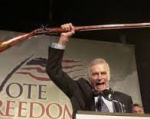I can see it now. The tumultuous last night of the 2016 Republican Convention. The newly-nominated Presidential candidate strides up to the podium flanked by family members and whomever is going to be the VP. Then he bends down, can’t be seen for a second stands back up and raises an AR over his head.
You think it can’t happen? You think that gun control couldn’t be the defining issue of the next Presidential campaign? I beg to differ with you and frankly, I even wish this little fantasy would come true. Why? Because if the election does turn on the gun issue, the folks who agree with the New York Times about banning assault rifles might just win.
 Before explaining, I have to mention the decision by the SCOTUS that denied certiorari to the appeal of the 7th Circuit’s decision that upheld the assault weapons ban in the town of Highland Park, Illinois. The ban was passed after Sandy Hook, as were similar bans enacted (and upheld) in Connecticut and New York. What was interesting about the denial of certiorari in the Highland Park case was the margin was 7 to 2; in other words, when it comes to protecting the 2nd Amendment rights of assault-rifle owners, as of now the usual 5-4 conservative majority that ruled in favor of Heller in 2008 has collapsed.
Before explaining, I have to mention the decision by the SCOTUS that denied certiorari to the appeal of the 7th Circuit’s decision that upheld the assault weapons ban in the town of Highland Park, Illinois. The ban was passed after Sandy Hook, as were similar bans enacted (and upheld) in Connecticut and New York. What was interesting about the denial of certiorari in the Highland Park case was the margin was 7 to 2; in other words, when it comes to protecting the 2nd Amendment rights of assault-rifle owners, as of now the usual 5-4 conservative majority that ruled in favor of Heller in 2008 has collapsed.
Given what just happened in San Bernardino, this decision should come as no great surprise. And luckily for all the Republican candidates, the news that the slaughter did constitute a real, ISIS-inspired terrorist attack, gave them all some way of responding without having to spend much time or verbiage on what has become the standard, red-meat rhetoric about the virtues of an armed citizenry, the dangers of gun-free zones, and all that other crap. This time around, defending the gun industry was left to Jerry Falwell, Jr., whose father, you may recall, blamed gays and lesbians for the World Trade Center attacks.
But let’s get back to which party would be helped and which would be hurt if an assault weapons ban was the driving campaign issue in 2016. And make no mistake about it, ISIS or no ISIS, there’s every good chance that between now and next November, at least one idiot will bring out his Bushmaster or his DPMS and try to even some real and/or imagined score. And I’ll take the short odds right now that the Republicans will make “defending the 2nd Amendment” the Number One plank in the GOP Platform next year, which means that the Democrats will have no choice but to call for some kind of ‘sensible gun control,’ which could mean a ban on black guns.
Here’s the bottom line on next year from a gun point of view. If Hillary gives up Nevada, Colorado, New Mexico, Minnesota and Florida but keeps the other states that voted blue in 2012 she still wins. Doesn’t win by much, but she wins. With the exception of Colorado, the others are all solid, gun-rich states. The bad news is that if she gives up those states, she has to keep states like Michigan, Wisconsin, Pennsylvania and Ohio in the Democratic column, which are also states with lots of voters who own guns. But ‘lots’ and 50% plus 1 is not the same thing. And it was the Democratic turnout in large, metropolitan areas in these states in 2012 which kept them blue. And most of those voters could care less about the 2nd Amendment or about guns.
The Democrats used to keep themselves below the radar screen on gun control as a campaign issue because the NRA took Gore to the showers in his defeat by George Bush. But 2016 isn’t 2000, and the country may not buy one more Sandy Hook. I don’t want any election to turn on the loss of human life, but put an AR in the wrong hands and it could work out that way, like it or not.



Recent Comments